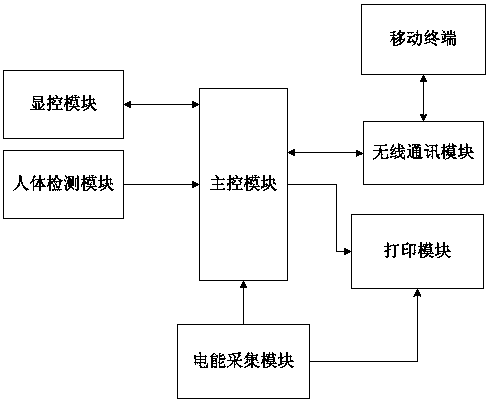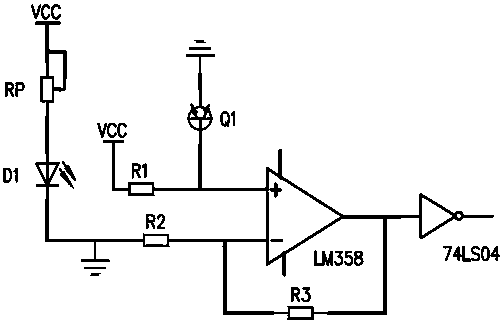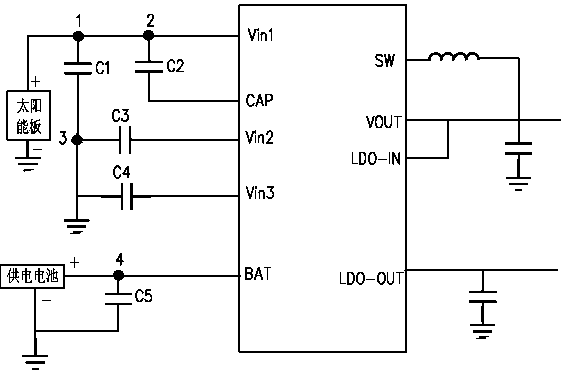Self-service wireless energy-saving printer
A printer and self-service technology, applied in printing devices, printing and other directions, can solve the problems of inconvenient portability, waste of power, and increased overall power consumption of self-service printers.
- Summary
- Abstract
- Description
- Claims
- Application Information
AI Technical Summary
Problems solved by technology
Method used
Image
Examples
Embodiment 1
[0023] A self-service wireless energy-saving printer of this embodiment, such as figure 1 Shown: a self-service wireless energy-saving printer, including a main control module, an electric energy collection module, a human body detection module, a wireless communication module, a display and control module, a printing module, and a mobile terminal.
[0024] The main control module is electrically connected to the electric energy collection module, the human body detection module, the display control module, the wireless communication module, and the printing module; the mobile terminal is connected to the main control module through the wireless communication module.
[0025] The printing module includes a USB chip and a USB printer, and the USB printer is connected to the main control module through the USB chip.
[0026] The electric energy collection module includes a photovoltaic panel and a light energy collector connected with the photovoltaic panel, and the light energy...
Embodiment 2
[0032] This embodiment is further optimized on the basis of embodiment 1, such as image 3 As shown: the light energy collector includes a chip U1, a first node, a second node, a third node, a fourth node, a capacitor C1, a capacitor C2, a capacitor C3, a capacitor C4, and a capacitor C5; the first nodes are respectively Connect the positive pole of the solar panel, the second node, and the capacitor C1, and the capacitor C1 is connected to the third node; the second node is respectively connected to the VIN1 interface of U1 and the capacitor C2, and the capacitor C2 is connected to the CAP interface of U1; the third nodes are respectively The VIN2 interface of U1 is connected through the capacitor C3, and the VIN3 interface of U1 is connected through C4; the fourth node is respectively connected with the positive pole of the power supply battery, the capacitor C5 and the BAT interface of U1, and the U1 is an LTC3330 chip. All power for this application is managed by the LTC33...
Embodiment 3
[0038] This embodiment is further optimized on the basis of Embodiment 2. When the printer prints the file, it specifically includes the following steps:
[0039] Step A: Detect whether the position of the printing paper is placed correctly;
[0040] Step B: If it is not placed correctly, automatically adjust the position of the printing paper, and then check again whether the position of the printing paper is correct, if it is placed correctly, print the current page and proceed to the next step;
[0041] Step C: Detect whether the currently printed printing paper is taken away;
[0042] Step D: If the removal of the printing paper is not detected within a certain period of time, the printing is terminated, and if the removal of the printing paper is detected, the next page is printed, and the next step is performed;
[0043] Step E: Repeat steps A to D until printing is complete.
[0044] Here, through the automatic printing detection method of the printer, it can effectiv...
PUM
 Login to View More
Login to View More Abstract
Description
Claims
Application Information
 Login to View More
Login to View More - R&D
- Intellectual Property
- Life Sciences
- Materials
- Tech Scout
- Unparalleled Data Quality
- Higher Quality Content
- 60% Fewer Hallucinations
Browse by: Latest US Patents, China's latest patents, Technical Efficacy Thesaurus, Application Domain, Technology Topic, Popular Technical Reports.
© 2025 PatSnap. All rights reserved.Legal|Privacy policy|Modern Slavery Act Transparency Statement|Sitemap|About US| Contact US: help@patsnap.com



